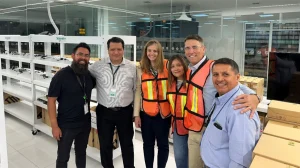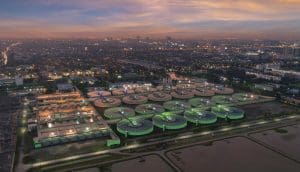We often see trees as solitary, static objects. But look closer; you’ll find they are dynamic, interconnected pieces part of a much larger ecosystem. It’s very much the same for our current approach to water management. Traditionally, we followed a linear model: resources are consumed, used, and discarded. This is an unsustainable approach. It ignores the interconnectedness of our natural systems and has led to resource depletion, high energy consumption, and waste generation.

For example, about 2 billion people lack access to safe drinking water, and 3.6 billion do not have access to safely managed sanitation. Half our global population experiences severe water scarcity for at least part of the year. These deficits are connected to a 10% increase in global migration. Global water scarcity has become urgent; continuing down this path is untenable.
The water sector must consider all assets as resources to be reused. This requires shifting our perspectives and practices to embrace a circular economy. By viewing water and its related processes not as isolated objects but as interconnected systems, we can enhance sustainability, optimize resource use, and improve efficiency.
Let’s explore this paradigm shift, the technological innovations that support it, and the challenges ahead for water management.
The circular economy concept in the water sector
The circular economy concept is a systemic approach to benefit businesses, society, and the environment. Unlike the traditional linear model, which follows a ‘take-make-dispose’ model, the circular version is regenerative and aims to decouple growth from consuming finite resources.
It’s a transformative shift that views water management as an interconnected process rather than an isolated activity:
- Resource regeneration: Companies minimize waste and continually reuse resources. Water is treated and recycled, reducing the demand for fresh water and lowering the environmental impact of wastewater disposal.
- Systemic thinking: Water systems are part of a larger, interconnected network. This perspective encourages integrated water management practices that consider the entire lifecycle of water use, from extraction to treatment and reuse.
- Value retention: Nutrients and energy can be recovered from wastewater (or ‘used’ water). These processes contribute to resource efficiency and sustainability – retaining the value of water in the system.
It’s worth noting that many water utilities have already begun renaming themselves as water recovery or water reclamation facilities to reflect their focus on sustainability and resource management.
Currents of change: Advances in water management technologies
The water sector can leverage innovations that enhance efficiency, sustainability, and resource management. These technologies enable real-time monitoring, optimize treatment processes, and integrate data for better decision-making, paving the way for more resilient water management systems. Some examples are:
- Digital twin technology: these virtual models of water systems enable real-time monitoring and optimization. The technology helps identify inefficiencies and predict maintenance needs, improving the overall performance of water management systems.
- Advanced treatment processes: Innovations like membrane bioreactors or aerobic granular sludge enhance the efficiency of wastewater treatment. This allows for higher-quality water recycling and resource recovery.
- Integrated water management platforms: AVEVA’s Unified Operations Center integrates data from various sources, providing a comprehensive view of water systems. This facilitates better decision-making and coordination across different sectors and stakeholders.
Navigating the whitewater: Overcoming obstacles and mobilizing stakeholders
Transitioning to a circular water management approach can be challenging. It requires developing a common data model, which enables businesses to share assets and process information efficiently. This is an important first step, as establishing a common language fosters collaboration within the organization and across the broader ecosystem of a circular community.
The unified framework also enables stakeholders to better align their efforts and drive innovation. However, even with this in place, there are still hurdles to overcome, such as securing investment, overcoming regulatory barriers, and shifting public perception toward accepting recycled water. These challenges can be addressed through coordinated stakeholder efforts, which foster innovation, as well as the implementation of strategic reforms:
- Adopting a TOTEX Approach: Total expenditure (TOTEX) considers both capital expenditure (CAPEX) and operational expenditure (OPEX) over the lifecycle of water management systems. This holistic view encourages investments in sustainable practices with higher upfront costs but lower long-term expenses.
- Enhancing Collaboration and Partnerships: Government bodies, private companies, and research institutions must collaborate to develop and implement circular economy practices. These partnerships lead to shared resources, knowledge, and technologies essential for overcoming systemic barriers and driving transformative change.
- Policy and Regulatory Reforms: Advocating for and implementing policy reforms that support circular economy practices is vital. Governments play a crucial role by setting standards for water recycling, providing financial incentives, and promoting research and development initiatives that encourage innovation and sustainable water management practices.
- Public Awareness and Education: Educating the public about the benefits of a circular economy and addressing misconceptions about recycled water is essential to gaining widespread support. Public awareness campaigns, supported by successful examples from cities like Singapore, demonstrate the effectiveness of these efforts.
Private companies can drive innovation by investing in advanced water treatment technologies and adopting best practices, such as digital twins and integrated management platforms. Meanwhile, research institutions contribute by facilitating the transfer of knowledge and technologies between academia, industry, and government through projects, training programs, and educational initiatives.
Reimagining water management as an interconnected process
The circular approach to water management can yield significant benefits: sustainability, efficiency, and environmental protection. Recycling and reusing water, as demonstrated in Schneider Electric’s Aquapolo success, reduces strain on freshwater resources, promoting long-term sustainability. Advanced technologies and optimized processes enhance efficiency, lowering energy consumption and operational costs.
Lastly, minimizing waste and pollution protects aquatic ecosystems and improves water quality, mitigating the adverse effects of wastewater disposal. This holistic approach paves the way for a sustainable and efficient future in water management.
A circular vision for a better water future
At Schneider Electric, we believe the growing challenges with our world’s water require fresh, creative solutions. As an innovation leader in the water management sector and one of the world’s most sustainable companies, we leverage our expertise in intelligent monitoring, energy efficiency, advanced analytics, and automation to optimize water processes, reduce costs, and help ensure water for everyone.
Our commitment to sustainability and technological innovation makes us an essential advisor for companies looking to enhance water management practices and align with global efforts towards more intelligent, more resilient water infrastructure.
To dive deeper into practical approaches to solving water scarcity, explore our water and wastewater solutions, and discover our water industry success stories. You can also watch our circularity webinar, “Developing Technology to Secure the Water Supply,” to learn more.




Add a comment